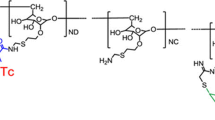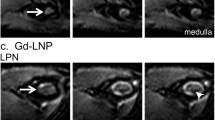Abstract
Nodal staging is an integral part of the pretreatment staging of any patient with malignancy and has therapeutic and prognostic implications. Currently used imaging techniques used for nodal evaluation are limited in accuracy because they rely on size criteria for the detection of metastases. This has led to the emergence of lymphotropic nanoparticle enhanced magnetic resonance imaging as a promising tool for nodal characterization. This article reviews the properties of lymphotropic iron oxide nanoparticles and the technique, image interpretation, and initial clinical experience with lymphotropic nanoparticle enhanced magnetic resonance imaging.







Similar content being viewed by others
References
Vassallo P, Matei C, Heston WD, McLachlan SJ, Koutcher JA, Castellino RA (1994) AMI-227–enhanced MR lymphography: usefulness for differentiating reactive from tumor-bearing lymph nodes. Radiology 193:501–506
Grubnic S, Vinnicombe SJ, Norman AR, Husband JE (2002) MR evaluation of normal retroperitoneal and pelvic lymph nodes. Clin Radiol 57:193–204
Yang WT, Lam WW, Yu MY, Cheung TH, Metreweli C (2000) Comparison of dynamic helical CT and dynamic MR imaging in the evaluation of pelvic lymph nodes in cervical carcinoma. AJR 175:759–766
Kim SH, Kim SC, Byung IC, Han MC (1994) Uterine cervical carcinoma: evaluation of pelvic lymph node metastasis with MR imaging. Radiology 190:807–811
Kim SH, Choi BI, Han JK, et al. (1993) Preoperative staging of uterine cervical carcinoma: comparison of CT and MRI in 99 patients. J Comput Assist Tomogr 17:633–640
Kim SH, Choi BI, Lee HP, et al. (1990) Uterine cervical carcinoma: comparison of CT and MR findings. Radiology 175:45–51
Hricak H, Lacey CG, Sandles LG, Chang YCF, Winkler ML, Stern JL (1988) Invasive cervical carcinoma: comparison of MR imaging and surgical findings. Radiology 166:623–631
Hricak H, Powell CB, Yu KK, et al. (1996) Invasive cervical carcinoma: role of MR imaging in pretreatment work-up—cost minimization and diagnostic efficacy analysis. Radiology 198:403–409
Roy C, Le Bras Y, Mangold L, et al. (1997) Small pelvic lymph node metastases: evaluation with MR imaging. Clin Radiol 52:437–440
Yu KK, Hricak H, Subak LL, Zaloudek CJ, Powell CB (1998) Preoperative staging of cervical carcinoma: phased array coil fast spin-echo versus body coil spin-echo T2-weighted MR imaging. AJR 171:707–711
Anzai Y, Piccoli CW, Outwater EK, et al. (2003) Evaluation of neck and body metastases to nodes with ferumoxtran 10-enhanced MR imaging: phase III safety and efficacy study. Radiology 228:777–788
Anzai Y, Blackwell KE, Hirschowitz SL, et al. (1994) Initial clinical experience with dextran-coated superparamagnetic iron oxide for detection of lymph node metastases in patients with head and neck cancer. Radiology 192:709–715
Hoffman HT, Quets J, Toshiaki T, et al. (2000) Functional magnetic resonance imaging using iron oxide particles in characterizing head and neck adenopathy. Laryngoscope 110:1425–1430
Sigal R, Vogl T, Casselman J, et al. (2002) Lymph node metastases from head and neck squamous cell carcinoma: MR imaging with ultrasmall superparamagnetic iron oxide particles (sinerem MR)—results of a phase-III multicenter clinical trial. Eur Radiol 12:1104–1113
Mack MG, Balzer JO, Straub R, Eichler K, Vogl TJ (2002) Superparamagnetic iron oxide–enhanced MR imaging of head and neck lymph nodes. Radiology 222:239–244
Harisinghani MG, Barentsz J, Hahn PF, et al. (2003) Noninvasive detection of clinically occult lymph–node metastases in prostate cancer. N Engl J Med 348:2491–2499
Deserno WM, Harisinghani MG, Taupitz M (2004) Urinary bladder cancer: preoperative nodal staging with ferumoxtran-10–enhanced MR imaging. Radiology 233:449–456
Stets C, Brandt S, Wallis F, Buchmann J, Gilbert FJ, Heywang-Kobrunner SH (2002) Axillary lymph node metastases: a statistical analysis of various parameters in MRI with USPIO. J Magn Reson Imaging 16:60–68
Michel SC, Keller TM, Frohlich JM, et al. (2002) Preoperative breast cancer staging: MR imaging of the axilla with ultrasmall superparamagnetic iron oxide enhancement. Radiology 225:527–536
Pannu HK, Wang KP, Borman TL, Bluemke DA (2000) MR imaging of mediastinal lymph nodes: evaluation using a superparamagnetic contrast agent. J Magn Reson Imaging 12:899–904
Nguyen BC, Stanford W, Thompson BH, et al. (1999) Multicenter clinical trial of ultrasmall superparamagnetic iron oxide in the evaluation of mediastinal lymph nodes in patients with primary lung carcinoma. J Magn Reson Imaging 10:468–473
Keller TM, Michel SC, Frohlich J, et al. (2004) USPIO-enhanced MRI for preoperative staging of gynecological pelvic tumors: preliminary results. Eur Radiol 14:937–944
Wang YX, Hussain SM, Krestin GP (2001) Superparamagnetic iron oxide contrast agents: physicochemical characteristics and applications in MR imaging. Eur Radiol 11:2319–2331
Weissleder R, Elizondo G, Wittenberg J, Rabito CA, Bengele HH, Josephson L (1990) Ultrasmall superparamagnetic iron oxide: characterization of a new class of contrast agents for MR imaging. Radiology 175:489–493
Weissleder R, Elizondo G, Wittenberg J, Lee AS, Josephson L, Brady TJ (1990) Ultrasmall superparamagnetic iron oxide: an intravenous contrast agent for assessing lymph nodes with MR imaging. Radiology 175:494–498
Bellin MF, Lebleu L, Meric JB (2003) Evaluation of retroperitoneal and pelvic lymph node metastases with MRI and MR lymphangiography. Abdom Imaging 28:155–163
Harisinghani MG, Dixon WT, Saksena MA, et al. (2004) MR lymphangiography: Imaging strategies to optimize the imaging of lymph nodes with ferumoxtran-10. Radiographics 24:867–878
Guimaraes R, Clement O, Bittoun J, Carnot F, Frija G (1994) MR lymphography with superparamagnetic iron nanoparticles in rats: pathologic basis for contrast enhancement. AJR 162:201–207
Clement O, Guimaraes R, de Kerviler E, Frija G (1994) Magnetic resonance lymphography. Enhancement patterns using superparamagnetic nanoparticles. Invest Radiol 29(suppl 2):S226–S228
Harisinghani M, Desermo W, Hahn PF, Barentsz J, Perumpilichiria J, Weissleder R (2002) MR lymphangiography for detection of minimal nodal disease in patients with prostate cancer: does postcontrast imaging alone suffice for accurate characterization [abstract]? Proceedings of the Radiological Society of North America; Chicago, Illinois; December 1–6, 2002. Radiology 225(P):350
Harisinghani M, Weissleder R (2004) Sensitive, noninvasive detection of lymph node metastases. PLoS Med 1:202–209
Harisinghani MG, Barentsz JO, Hahn PF, et al. (2002) MR lymphangiography for detection of minimal nodal disease in patients with prostate cancer. Acad Radiol 9(suppl 2):S312–S313
Bellin MF, Roy C, Kinkel K, et al. (1998) Lymph node metastases: safety and effectiveness of MR imaging with ultrasmall superparamagnetic iron oxide particles—initial clinical experience. Radiology 207:799–808
Carter CL, Allen C, Henson DE (1989) Relation of tumor size, lymph node status, and survival in 24,740 breast cancer cases. Cancer 63:181–187
Fisher B, Bauer M, Wickerham DL (1983) Relation of number of positive axillary nodes to the prognosis of patients with primary breast cancer. An NSABP update. Cancer 52:1551–1557
Author information
Authors and Affiliations
Corresponding author
Additional information
An erratum to this article can be found online at http://dx.doi.org/10.1007/s00261-011-9717-x
Rights and permissions
About this article
Cite this article
Saokar, A., Braschi, M. & Harisinghani, M. Lymphotrophic nanoparticle enhanced MR imaging (LNMRI) for lymph node imaging. Abdom Imaging 31, 660–667 (2006). https://doi.org/10.1007/s00261-006-9006-2
Published:
Issue Date:
DOI: https://doi.org/10.1007/s00261-006-9006-2




